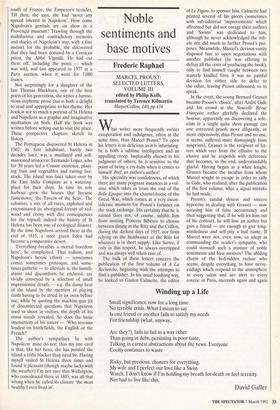Attending to imperial balls
David Wright
THE EMPEROR'S LAST ISLAND by Julia Blackburn Secker, .06.99, pp. 244 Barring Tristan da Cunha, the island of St Helena is perhaps the most remote, least visited, and difficult-to-get-to remnant of the sometime Empire. A volcanic peak sticking out of mid-Atlantic, it has no air- field; the Union-Castle liners that used to call once a fortnight no longer run between Tilbury and Cape Town; its only link with what passes for civilisation is a cargo-boat bringing stores, provisions, returning islanders and an occasional Governor- General — who is liable to be marooned there at the end of his term, if as may happen, the boat is delayed. The island's fame has come from its role as prison for superior captives — apart from Bonaparte, it is the place where the Zulu king Cetewayo, the Sultan of Zanzibar, and one or two Boer generals, have all done porridge.
Julia Blackburn needed imagination, persistence and courage to visit the island with her young family. Though St Helena is haunted by the 25 years of Napoleon's presence — of which two decades were spent in a tomb — nevertheless it was not his legend that drew her to the island but the somewhat bizarre accident of coming across, on display in a small museum in the
south of France, the Emperor's testicles. Till then, she says, she had 'never any special interest in Napoleon'. How come Napoleon's genitals are on show in a Provençal museum? Trawling through the multifarious ahd contradictory memoirs and diaries of Napoleon's stay, with a fine instinct for the probable, she discovered that they had been donated by a Corsican priest, the Abbe Vignalli. He had cut them off, including the penis — which was sold, and last appeared in 1977 at a Paris auction, when it went for 7,000 francs.
Not surprisingly for a daughter of the late Thomas Blackburn, one of the best poets of his generation, she writes a harmo- nious euphonic prose that is both a delight to read and appropriate to her theme. Her book is not so much a portrait of St Helena and Napoleon as a graphic and imaginative meditation on both. Half the book was written before setting out to visit the place. These prospective chapters sketch its history.
The Portuguese discovered St Helena in 1502; its first inhabitant, barely two decades later, was a mutilated and self- marooned aristocrat, Fernando Lopez, who for 30 years led a Crusoe existence, plant- ing fruit and vegetables and raising live- stock. The island was later taken over by the East India Company as a watering- place for their ships. In time its sole harbour grew the houses that became Jamestown, 'the Tavern of the Seas'. The colonists, a mix of all races, exploited and exterminated its aboriginal forests of red- wood and ebony with dire consequences for the topsoil: indeed the history of St Helena has been one of ecological disaster. By the time Napoleon arrived there at the end of 1815, a once green Eden had become a comparative desert.
'Everything breathes a mortal boredom here', he complained. That tedium, and Napoleon's heroic efforts — sometimes comic, sometimes grotesque, and some- times pathetic — to alleviate it, the humili- ations and discomforts he endured, are vividly conveyed by a selection of small impressionist details — e.g. the damp heat of the island by the mention of playing cards having to be dried in an oven before use; while by quoting the machine-gun jet of disconnected questions that Napoleon used to shoot at visitors, the depth of his ennui stands revealed. So does the basic insensitivity of his nature — 'Who screams loudest on battlefields, the English or the French?'
The author's sympathies lie with Napoleon: mine do not: thus my one cavil is that, like her hero, she has painted the island a trifle blacker that? need be. Having myself visited St Helena three times and found it pleasant (though maybe lucky with the weather) I'm not sure that Wellington, who convalesced there in 1805, was all that wrong when he called its climate 'the most healthy I ever lived in'.



















































 Previous page
Previous page